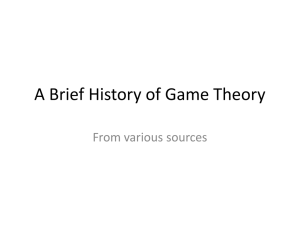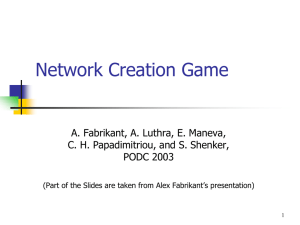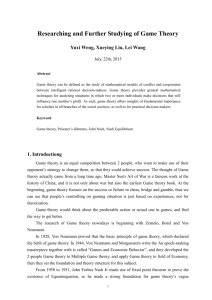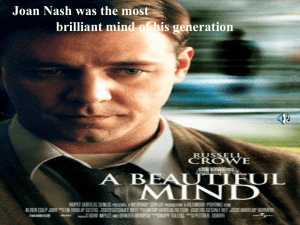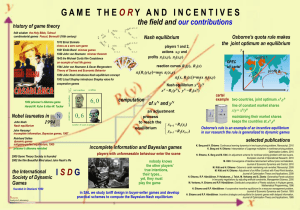Slide Deck 2 - Game Theory Lab, CSA
advertisement
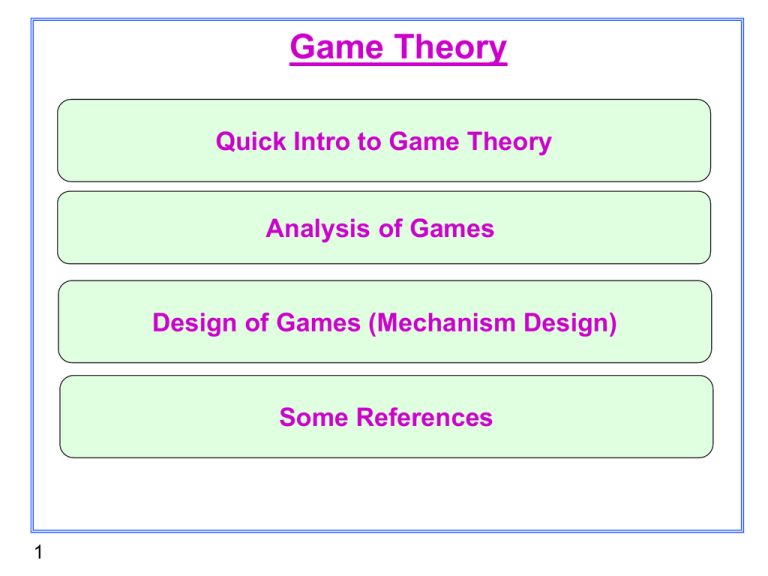
Game Theory
Quick Intro to Game Theory
Analysis of Games
Design of Games (Mechanism Design)
Some References
1
John von Neumann
The Genius who created two intellectual currents in the 1930s, 1940s
Founded Game Theory
with Oskar Morgenstern
(1928-44)
Pioneered the Concept of
a Digital Computer and
Algorithms (1930s)
2
Robert Aumann
Nobel 2005
Leonid Hurwicz
Nobel 2007
Recent Excitement :
Nobel Prizes for
Game Theory and
Mechanism Design
The Nobel Prize was awarded to
two Game Theorists in 2005
Thomas Schelling
Nobel 2005
Eric Maskin
Nobel 2007
The prize was awarded to three
mechanism designers in 2007
Roger Myerson
Nobel 2007
3
Game Theory
Mathematical framework for rigorous study of conflict
and cooperation among rational, intelligent agents
Market
Buying Agents
(rational and
intelligent)
Social Planner
Selling Agents
(rational and
intelligent)
In the Internet Era, Game Theory has become a
valuable tool for analysis and design
4
Applications of Game Theory
Microeconomics, Sociology, Evolutionary Biology
Auctions and Market Design: Spectrum Auctions,
Procurement Markets, Double Auctions
Industrial Engineering, Supply Chain Management,
E-Commerce, Procurement, Logistics
Computer Science: Algorithmic Game Theory,
Internet and Network Economics,
Protocol Design, Resource Allocation, etc.
5
A Familiar Game
Mumbai
Indians
1
Kolkata
Knight Riders
2
Bangalore
RoyalChallengers
3
Punjab Lions
Sachin Tendulkar
4
IPL Franchisees
IPL CRICKET AUCTION
Sponsored Search Auction
Advertisers
1
2
n
CPC
Major money spinner for all search engines and web portals
7
DARPA Red Balloon Contest
Mechanism Design Meets Computer Science, Communications of the ACM, August 2010
8
Procurement Auctions
SUPPLIER 1
SUPPLIER 2
Buyer
SUPPLIER n
Supply (cost) Curves
Budget Constraints, Lead Time Constraints, Learning by Suppliers,
Learning by Buyer, Logistics constraints, Combinatorial Auctions,
Cost Minimization, Multiple Attributes
KEY OBSERVATIONS
Players are rational,
Intelligent, strategic
Both conflict and
cooperation are “issues”
Some information is
“common knowledge”
Other information is
“private”, “incomplete”,
“distributed”
Our Goal: To implement a system wide solution
(social choice function) with desirable properties
Game theory is a natural choice for modeling
such problems
10
Strategic Form Games (Normal Form Games)
S1
Sn
N = {1,…,n}
Players
S1, … , Sn
Strategy Sets
S = S1 X … X Sn
11
U1 : S
R
Un : S
R
Payoff functions
(Utility functions)
Example 1: Coordination Game
B
RVCE
MG Road
RVCE
100,100
0,0
MG Road
0,0
10,10
A
Models the strategic conflict when two players
have to choose their priorities
12
Example 2: Prisoner’s Dilemma
No Confess
Confess
NC
C
No Confess
NC
- 2, - 2 - 10, - 1
Confess
C
13
-1, - 10 - 5, - 5
Pure Strategy Nash Equilibrium
A profile of strategies s1* , s 2* ,...,s n*
is said to be
a pure strategy Nash Equilibrium if si* is a best
response strategy against s*i i 1,2,...,n
A Nash equilibrium profile is robust to unilateral
deviations and captures a stable, self-enforcing
agreement among the players
14
Nash Equilibria in Coordination Game
B
College
Movie
College
100,100
0,0
Movie
0,0
10,10
A
Two pure strategy Nash equilibria: (College,College)
and (Movie, Movie);
one mixed strategy Nash equilibrium
15
Nash Equilibrium in Prisoner’s Dilemma
No Confess
Confess
NC
C
No Confess
NC
- 2, - 2 - 10, - 1
Confess
C
-1, - 10 - 5, - 5
(C,C) is a Nash equilibrium
16
Relevance/Implications of
Nash Equilibrium
17
Players are happy
the way they are;
Do not want to
deviate unilaterally
Stable, self-enforcing,
self-sustaining
agreement
Provides a principled
way of predicting a
steady-state outcome of
a dynamic
Adjustment process
Need not correspond
to a socially optimal or
Pareto optimal
solution
Example 3: Traffic Routing Game
C
45
x/100
B
A2
Destination
Source
x/100
45
D
N = {1,…,n}; S1 = S2 = … = Sn = {C,D}
Traffic Routing Game: Nash Equilibrium
C
45
x/100
B
A2
Destination
Source
x/100
45
D
Assume n = 4000
U1 (C,C, …, C) = - (40 + 45) = - 85
U1 (D,D, …, D) = - (45 + 40) = - 85
U1 (D,C, …, C) = - (45 + 0.01) = - 45.01
U1 (C, …,C;D, …,D) = - (20 + 45) = - 65
Any Strategy Profile
with 2000 C’s and
2000 D’s is a
Nash Equilibrium
Traffic Routing Game: Braess’ Paradox
C
45
x/100
B
0
A2
Destination
Source
x/100
45
D
Assume n = 4000
S1 = S2 = … = Sn = {C,CD, D}
U1 (CD,CD, …, CD) = - (40+0+40) = - 80
U1 (C,CD, …, CD) = - (40+45) = - 85
U1 (D,CD, …, CD) = - (45+40) = - 85
Strategy Profile
with 4000 CD’s is
the unique
Nash Equilibrium
Nash’s Beautiful Theorem
Every finite strategic form
game has at least one mixed
strategy Nash equilibrium;
Computing NE is one of the
grand challenge problems in CS
Game theory is all about analyzing
games through such solution concepts and
predicting the behaviour of the players
Non-cooperative game theory and cooperative
game theory are the major categories
21
MECHANISM DESIGN
Game Theory involves analysis of games –
computing NE, DSE, MSNE, etc and
analyzing equilibrium behaviour
Mechanism Design is the design of games or
reverse engineering of games; could be called
Game Engineering
Involves inducing a game among the players
such that in some equilibrium of the game,
a desired social choice function is implemented
22
Example 1: Mechanism Design
Fair Division of a Cake
Mother
Social Planner
Mechanism Designer
Kid 1
Rational and
Intelligent
Kid 2
Rational and
Intelligent
Example 2: Mechanism Design
Truth Elicitation through an Indirect Mechanism
Tenali Rama
(Birbal)
Mechanism Designer
Mother 1
Rational and
Intelligent Player
Baby
Mother 2
Rational and
Intelligent Player
Mechanism Design: Example 3
Vickrey Auction
1 1
40
2
45
3
60
4
80
Buyers
William Vickrey
(1914 – 1996 )
Nobel Prize: 1996
25
Winner = 4
Price = 60
Four Basic Types of Auctions
Dutch Auction
English Auction
1
1
0, 10, 20, 30,
40, 45, 50, 55,
58, 60, stop.
n
100, 90, 85,
75, 70, 65, 60,
stop.
Seller
Buyers
Auctioneer or seller
Buyers
Vickrey Auction
First Price Auction
1
40
2
50
3
55
4
60
Buyers
26
40
1
Winner = 4
Price = 60
n
2
45
3
60
4
80
Buyers
Winner = 4
Price = 60
Vickrey-Clarke-Groves (VCG)
Mechanisms
Vickrey
Clarke
Groves
Only mechanisms under a quasi-linear setting satisfying
Allocative Efficiency
Dominant Strategy Incentive Compatibility
27
Concluding Remarks
Game Theory and Mechanism Design have
numerous, high impact applications in the
Internet era
Game Theory, Machine Learning, Optimization,
and Statistics have emerged as the most
important mathematical tools for engineers
Algorithmic Game Theory is now one of the most
active areas of research in CS, ECE, Telecom, etc.
Mechanism Design is extensively being used in IEM
It is a wonderful idea to introduce
game theory and mechanism design at the
BE level for CS, IS, EC, IEM; to be done with care
28
REFERENCES
Martin Osborne. Introduction to Game Theory.
Oxford University Press, 2003
Roger Myerson. Game Theory and Analysis of
Conflict. Harvard University Press, 1997
A, Mas-Colell, M.D. Whinston, and J.R. Green.
Microeconomic Theory, Oxford University Press, 1995
N. Nisan, T. Roughgarden, E. Tardos, V. Vazirani
Algorithmic Game Theory, Cambridge Univ. Press, 2007
29
REFERENCES (contd.)
Y. Narahari,
Essentials of Game Theory and Mechanism Design
IISc Press, 2012 (forthcoming)
http://www.gametheory.net
A rich source of material on game theory and game
theory courses
http://lcm.csa.iisc.ernet.in/hari
Course material and
several survey articles can be downloaded
Y. Narahari, Dinesh Garg, Ramasuri, and Hastagiri
Game Theoretic Problems in Network Economics
and Mechanism Design Solutions, Springer, 2009
30
Cooperative Game with Transferable
Utilities
T ( N , v)
N {1,2,...,n} set of players
v : 2 N characteristic function ; v( ) 0
C N is called a c o a litio.n
T hereare 2| N | 1 possible coalitions
Divide the Dollar Game
There are three players who have to share 300 dollars.
Each one proposes a particular allocation of dollars to
players.
N {1,2,3}
S1 S 2 S3 {( x1 , x2 , x3 ) 3 : x1 0; x2 0; x3 0;
x1 x2 x3 300}
Divide the Dollar : Version 1
The allocation is decided by what is proposed by player 0
ui ( s1 , s2 , s3 ) xi
0
if s1 ( x1 , x2 , x3 )
otherwise
Characteristic Function
v({1}) 300
v({2}) v({3}) v({2,3}) 0
v({1,2}) v({1,3}) v({1,2,3}) 300
Divide the Dollar : Version 2
It is enough 1 and 2 propose the same allocation
ui ( s1 , s2 , s3 ) xi
0
if s1 s2 ( x1 , x2 , x3 )
otherwise
Players 1 and 2 are equally powerful; Characteristic Function is:
v({1}) v({2}) v({3}) 0
v({1,2}) 300
v({1,3}) v({2,3}) 0
v({1,2,3}) 300
Divide the Dollar : Version 3
Either 1 and 2 should propose the same allocation or 1 and 3
should propose the same allocation
ui ( s1 , s2 , s3 ) xi
0
if s1 s2 ( x1 , x2 , x3 ) or s1 s3 ( x1 , x2 , x3 )
otherwise
Characteristic Function
v({1}) v({2}) v({3}) v({2,3}) 0
v({1,2}) v({1,3}) v({1,2,3}) 300
Divide the Dollar : Version 4
It is enough any pair of players has the same proposal
ui ( s1 , s2 , s3 ) xi
if s1 s2 ( x1 , x2 , x3 )
or s1 s3 ( x1 , x2 , x3 )
or s2 s3 ( x1 , x2 , x3 )
0
otherwise
Also called the Majority Voting Game
Characteristic Function
v({1}) v({2}) v({3}) 0
v({1,2}) v({1,3}) v({2,3}) v({1,2,3}) 300
Shapley Value of a Cooperative Game
Captures how competitive forces
influence the outcomes of a game
Describes a reasonable and fair way
of dividing the gains from cooperation
given the strategic realities
Shapley value of a player finds its
average marginal contribution across
all permutation orderings
Lloyd Shapley
37
Unique solution concept that satisfies
symmetry, preservation of carrier,
additivity, and Pareto optimality
Shapley Value : A Fair Allocation Scheme
Provides a unique payoff allocation that describes a fair way
of dividing the gains of cooperation in a game (N, v)
(v) ( 0 (v),..., n (v))
w here
i (v )
| C |!(| N | | C | 1)!
{v(C {i}) v(C )}
| N |!
C N i
Shapley Value: Examples
Version of Divide-the-Dollar
Shapley Value
Version 1
(300, 0, 0)
Version 2
(150, 150, 0)
Version 3
(200, 50, 50)
Version 4
(100, 100, 100)
